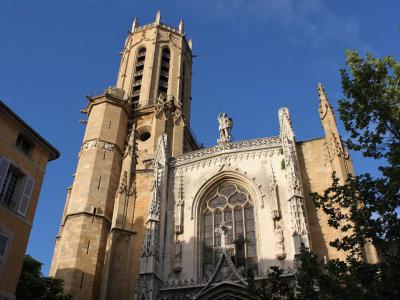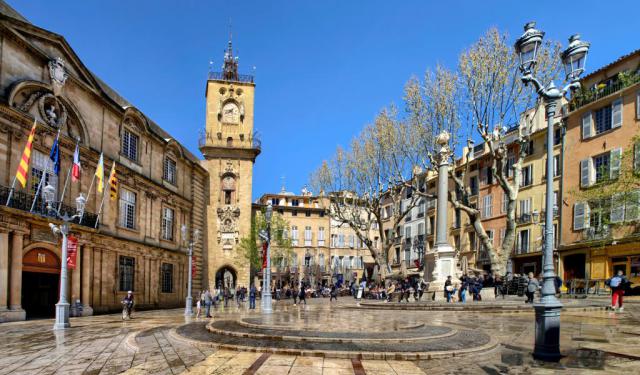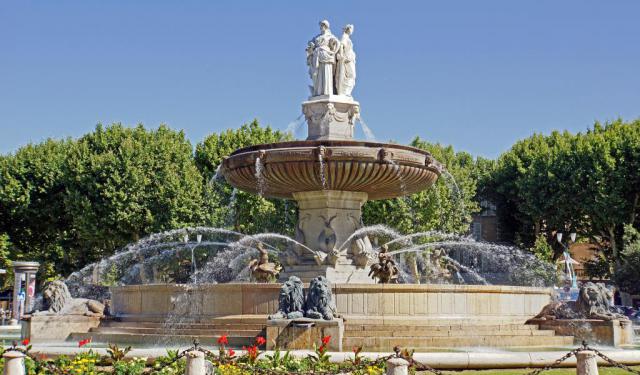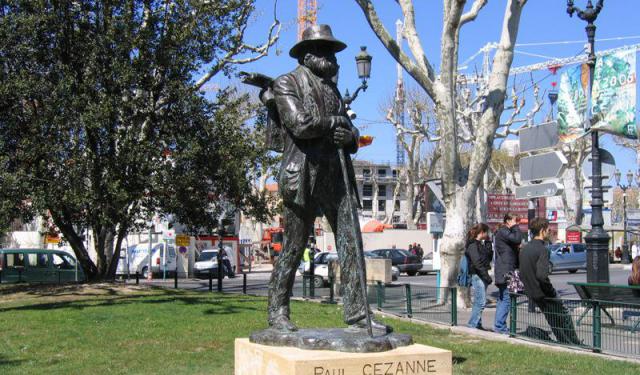Cathedrale Saint-Sauveur d'Aix-en-Provence (Aix Cathedral), Aix-en-Provence (must see)
Seventeenth-century writer Jean Pitton claimed that Aix Cathedral rose where a Roman temple to Apollo once stood-proof that even the gods can’t hold onto prime real estate forever. The site’s first church was reportedly founded around 500 AD by Saint Maximinus, who, according to tradition, arrived from Jerusalem with Mary Magdalene in a boat generously lent by Saint Lazarus. Apparently divine Uber was a thing back then.
The cathedral we see today took root in the 12th century with a solid Romanesque nave. Then came a second one in 1171, dedicated to Saint Maximinus himself, squeezing in between the original nave and baptistry like a holy architectural remix. The 14th century brought more flair, with a Gothic-style transept added in 1318-clearly, Aix was keeping up with cathedral trends.
Outside, the façade is a theatrical display of late Gothic drama: pointed arches, slim yellowish buttresses, and twelve Apostles playing hide-and-seek in the niches-three upfront, the rest loitering in the wings. Above it all, Archangel Michael takes center stage, dramatically skewering a dragon atop the balustrade. The walnut portal doors, carved in 1505, add a final flourish of detail, leading into a space that juggles three styles-Romanesque on one side, Gothic down the middle, and Baroque along the north.
Inside, it’s not just architecture on show. You’ll find the 5th-century baptistry with Roman columns still holding their ground, plus a high altar supported by bronze figures of the Holy Trinity. The walls display works by Nicolas Froment, Jean Daret, and Louis Finson-a follower of Caravaggio known for his dramatic flair. One standout treasure is a set of 16th-century tapestries, originally woven for Canterbury Cathedral and brought to Aix long before international art loans became the norm.
And then there’s Cézanne. The hometown icon, who once called Aix the best place to live, painted the cathedral repeatedly from a spot just a short walk from his studio.When he died in 1906, it was here-under the watch of archangels, apostles, and centuries of layered stone-that he took his final bow.
The cathedral we see today took root in the 12th century with a solid Romanesque nave. Then came a second one in 1171, dedicated to Saint Maximinus himself, squeezing in between the original nave and baptistry like a holy architectural remix. The 14th century brought more flair, with a Gothic-style transept added in 1318-clearly, Aix was keeping up with cathedral trends.
Outside, the façade is a theatrical display of late Gothic drama: pointed arches, slim yellowish buttresses, and twelve Apostles playing hide-and-seek in the niches-three upfront, the rest loitering in the wings. Above it all, Archangel Michael takes center stage, dramatically skewering a dragon atop the balustrade. The walnut portal doors, carved in 1505, add a final flourish of detail, leading into a space that juggles three styles-Romanesque on one side, Gothic down the middle, and Baroque along the north.
Inside, it’s not just architecture on show. You’ll find the 5th-century baptistry with Roman columns still holding their ground, plus a high altar supported by bronze figures of the Holy Trinity. The walls display works by Nicolas Froment, Jean Daret, and Louis Finson-a follower of Caravaggio known for his dramatic flair. One standout treasure is a set of 16th-century tapestries, originally woven for Canterbury Cathedral and brought to Aix long before international art loans became the norm.
And then there’s Cézanne. The hometown icon, who once called Aix the best place to live, painted the cathedral repeatedly from a spot just a short walk from his studio.When he died in 1906, it was here-under the watch of archangels, apostles, and centuries of layered stone-that he took his final bow.
Want to visit this sight? Check out these Self-Guided Walking Tours in Aix-en-Provence. Alternatively, you can download the mobile app "GPSmyCity: Walks in 1K+ Cities" from Apple App Store or Google Play Store. The app turns your mobile device to a personal tour guide and it works offline, so no data plan is needed when traveling abroad.
Cathedrale Saint-Sauveur d'Aix-en-Provence (Aix Cathedral) on Map
Sight Name: Cathedrale Saint-Sauveur d'Aix-en-Provence (Aix Cathedral)
Sight Location: Aix-en-Provence, France (See walking tours in Aix-en-Provence)
Sight Type: Religious
Guide(s) Containing This Sight:
Sight Location: Aix-en-Provence, France (See walking tours in Aix-en-Provence)
Sight Type: Religious
Guide(s) Containing This Sight:
Walking Tours in Aix-en-Provence, France
Create Your Own Walk in Aix-en-Provence
Creating your own self-guided walk in Aix-en-Provence is easy and fun. Choose the city attractions that you want to see and a walk route map will be created just for you. You can even set your hotel as the start point of the walk.
Aix-en-Provence Introduction Walking Tour
Aix-en-Provence may not have coastal views, but it compensates in style with its Roman bathwater and city logistics. Founded in 123 BC by Roman consul Gaius Sextius Calvinus, this southern French settlement-originally named Aquae Sextiae, which means “Waters of Sextius”-was built around its thermal springs and the promise of a good soak. Centuries later, the name was streamlined to “Aix”,... view more
Tour Duration: 1 Hour(s)
Travel Distance: 1.7 Km or 1.1 Miles
Tour Duration: 1 Hour(s)
Travel Distance: 1.7 Km or 1.1 Miles
Aix-en-Provence Fountains and Squares Tour
Aix-end-Provence is known for its fountains. With more than 1,000 fountains, a tourist could spend weeks walking around the city without glimpsing them all. The fountains began appearing under the Roman empire when the Romans discovered Aix's natural thermal water source. They referred to the area as Aquae Sextiae or the Waters of Sextius.
The fountains appear throughout the city and are... view more
Tour Duration: 1 Hour(s)
Travel Distance: 1.6 Km or 1 Miles
The fountains appear throughout the city and are... view more
Tour Duration: 1 Hour(s)
Travel Distance: 1.6 Km or 1 Miles
In the Footsteps of Paul Cézanne
Paul Cézanne, often called the “father of modern art” for bridging 19th-century post-impressionism and the birth of early modernism, caused a bit of a stir early in his career. While staying with Doctor Gachet in Auvers-sur-Oise, he painted his take on Manet’s Olympia-but with a twist. Instead of just a reclining nude, Cézanne inserted himself into the scene, back turned, like a shy... view more
Tour Duration: 2 Hour(s)
Travel Distance: 3.0 Km or 1.9 Miles
Tour Duration: 2 Hour(s)
Travel Distance: 3.0 Km or 1.9 Miles






